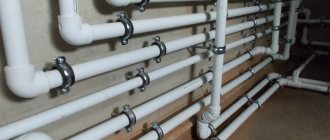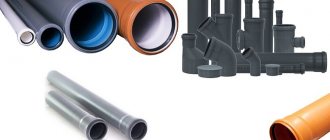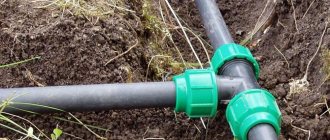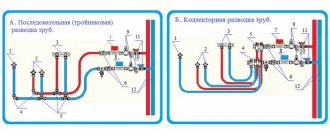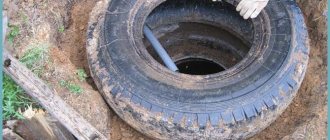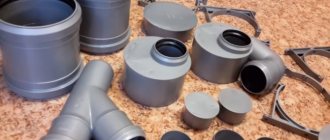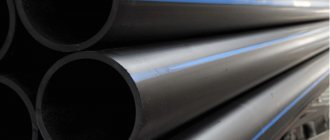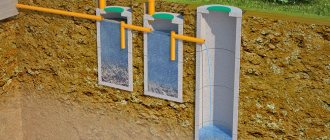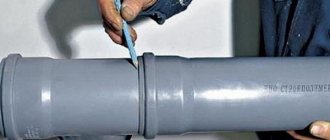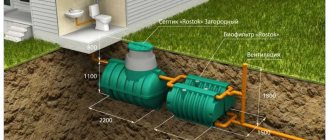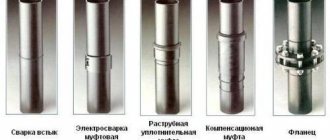Pipes made from a symbiosis of metal and plastic are produced for the construction of intra-house highways. The new products made it possible to assemble a water supply and heating system yourself, without involving plumbers. Pipelines serve for a long time, are installed extremely simply and quickly, without creating problems even for inexperienced craftsmen.
By installing metal-plastic pipes yourself, you can save a lot of money, preserving the family budget for more important expenses. To install them, a home craftsman only needs to stock up on an easy-to-use tool, patience and knowledge, which we are ready to share with site visitors.
We will tell you everything about the specifics of using metal-plastic products and methods of connecting pipelines assembled from them. The article describes in detail the negative and positive aspects of their use. Here you will learn how to install trouble-free systems.
Features of metal-plastic products
Metal-plastic (metal-polymer pipes) are composite products for the production of which various types of materials are used. Such elements have an attractive appearance, good wear resistance, elasticity, and strength.
Metal-plastic pipes are distinguished by high consumer qualities (strength, flexibility, resistance to high temperatures and aggressive substances), as well as an aesthetic appearance
Typically, a pipe consists of five layers. A durable polymer, usually cross-linked polyethylene, is used as a supporting base. It makes the inner surface smooth, protecting it from blockages, and also contributes to the strength of the product.
An adhesive is applied to the core, on which aluminum foil that stabilizes the pipe is attached (it also prevents the ingress of oxygen). The connection is secured by butt or overlap welding.
The design of a metal-plastic pipe involves the use of five layers of different materials: two layers of polyethylene, two layers of glue, a layer of aluminum foil
The fourth layer is also applied with glue, to which the outer covering is connected - white polyethylene, which provides protection to the product and gives it an aesthetic appearance.
Metal-plastic or polypropylene, which is better for plumbing?
Comparison of systems
When installing a new or replacing an old water supply system, the question often arises:
“Which elements should I give preference: metal-plastic or polypropylene?”
Many people believe that metal plastic is much better than the thermoplastic polymer propylene, and here's why.
Products differ:
- small coefficient of linear expansion, which is essential when using them when installing systems for supplying hot water;
- high ability to retain the original shape. This is important not only in terms of visual appeal, but also from a technical point of view;
- absolute tightness.
Important! To increase hygienic properties, many metal-plastic models are coated with silver (a very thin layer) from the inside at the nanolevel.
Silver particles have the property of destroying harmful microorganisms, and also eliminate the possibility of sediment settling on the inner wall.
Despite the advantages of the first option, polypropylene analogues provide successful competition.
They differ:
- high strength;
- resistance to mechanical damage;
- absence of delamination;
- resistance to chemically active substances.
Important! The presence of antioxidants in polypropylene helps to increase the resistance of products to chemically active chlorine. Taking this fact into account, polypropylene collectors began to be used for transporting drinking water.
Criteria for choosing between metal-plastic and polypropylene
To make the right choice, it is necessary to analyze the criteria, in particular:
- Purpose of the product. For cold water pipes, it is better to choose polypropylene pipes. When choosing the best option for moving hot water, it is advisable to consult with professionals.
- The quality of the material on which the life of the system depends. Therefore, when purchasing, you should pay attention to the availability of certificates of conformity.
- Performance and technical characteristics. You need to be sure that the parts can function in specific conditions.
- Installation type. Highways made from both materials can be assembled with your own hands.
- Price.
Technical characteristics of pipes D 16-20 mm
Here are the data typical for metal-plastic pipes of common diameters (16 and 20 mm):
- The wall thickness is 2 and 2.25 millimeters, respectively; The thickness of the aluminum layer is 0.2 and 0.24 mm.
- One running meter weighs 115 and 170 grams and holds a volume of liquid equal to 1.113 and 0.201 liters.
- The thermal conductivity coefficient is 0.43 W/m K, the expansion rate of metal-plastic is 0.26x104 per 1 degree Celsius, the roughness coefficient is 0.07.
- When the material breaks transversely, the strength coefficient is 2880 N.
- The strength of the connection between the adhesive layer and the foil is 70 N/10 sq. mm, the strength coefficient of the aluminum welded layer is 57 N/sq. mm.
- Metal-plastic pipes can operate even at +95o C, briefly withstanding temperatures of +110-130o C.
- Within the temperature range from 0 to +25o C, the system operates at a pressure of up to 25 bar, and at +95o C it can withstand a pressure of 10 bar.
- The tightness and integrity of the metal-plastic pipe is broken under a load of 94 bar (at +20° C).
With proper installation and compliance with operating rules, products made of metal-polymers can last 50 years or more.
Areas of application of metal-plastic elements
Pipes made of metal polymers are widely used in the construction of individual houses, in industrial construction and agriculture.
The main areas of their use are:
- transportation of liquids, gaseous agents;
- laying drainage systems, water pipes, heating;
- in structures involving the transfer of compressed air;
- supplying heating components to radiators, installing heated floors;
- installation of air conditioning circuits;
- protection and shielding of wires (primarily power);
- construction of irrigation systems.
Metal-plastic is not recommended for use:
- when organizing central heating systems with the proposed construction of elevator units;
- in places with an assigned fire safety level “G”;
- with the expected supply of hot liquid in the pipeline with a working pressure >10 bar;
- in rooms where it is planned to place sources of thermal radiation with a surface temperature of over 150 degrees C.
In addition, it is undesirable to use metal-polymer pipes in safety, signal, overflow, expansion circuits and in fire-fighting water supply systems.
Metal-plastic products are widely used in private and industrial construction. This photo shows pipes used for laying heating systems
Three main methods of pipe routing
The wiring of metal-plastic systems can be carried out using different methods, each of which is selected based on the feasibility and possibilities of further access to the system.
Option #1: hidden
In this case, all pipes and connections are hidden deep in the wall under the finishing materials. Only fittings and bends for connecting plumbing fixtures are exposed outside.
The hidden installation method involves installing the structure in the wall, where recesses are specially prepared for pipes, after which the surface is sealed
When using this installation method, the interior design is preserved, in addition, masking communications protects them from accidental damage.
This option has several disadvantages:
- Laying channels for pipes requires a complex and labor-intensive gating process. After laying communications, the surface must be restored again.
- This method is not suitable for load-bearing walls, where gating is prohibited by regulatory documents.
- Quite a high cost associated with additional work.
This method is best used when renovating a bathroom. It is not advisable to install a hidden installation in an already decorated room, since this will require complete dismantling of the wall covering (cladding, plaster).
Option #2: open
If for some reason the pipes cannot be hidden in the wall, they can be laid along its surface. This option is more convenient for visual inspection of joints, which allows, if necessary, to quickly clean the area or replace a component.
With the open method, pipes are laid along the surface of the wall, which allows for control of connections and reduces the cost of work
Open wiring can be used in rooms that have already been renovated, since the installation will not harm the design of the walls. The advantages of this method include its ease and lower cost of work than when laying internal communications.
Option #3: combined
In this case, the pipes are laid along the surface of the unfinished walls, after which they are covered with boxes or false panels. This is a rather complex method, since it requires the perfect fit of decorative elements into the interior, which can also be used as drywall, tiles and other materials.
Wiring diagrams for bathrooms and bathrooms
For plumbing work carried out in bathrooms and toilets, three layouts of metal-plastic pipes can be used. For private houses, the most rational option is to use a collector.
Efficient collector system
A reliable and practical option that involves connecting each object to a central pipe through a supply pair. This allows the faucet to regulate or turn off the water supply to each specific plumbing fixture.
With parallel wiring, each plumbing fixture is equipped with its own water line and its own shut-off valve. All branches come out of one device - the collector
All control devices are located in a compact manifold, which is placed in a space specially designated for them (cabinet).
Supply pipes with a minimum of connections do not require special control, which allows for hidden installation. The disadvantage of this option is the rather high cost, since for each connection you will need to purchase a special shut-off valve. Since such a system is quite complex, work must be done carefully and carefully.
In collector water distribution, control devices and shut-off devices are installed on the pipe supplying water to the collector
An important advantage: if a separate item (washing machine, faucet) fails, there is no need to completely disconnect the bathroom from the water supply - just turn off the necessary shut-off valve.
Serial connection system
This option involves connecting each plumbing item to the main pipe using a separate tee. It is more suitable for bathrooms with a minimum number of objects (washing machine, common faucet).
Sequential wiring, shown schematically in the figure, is recommended for use in rooms with a small number of objects that are alternately connected to pipes using tees
A sequential scheme can be implemented after finishing work has been completed in the room, using an open laying system. The assembly process is quite simple: the pipe is laid from one object to another, and at the same time the supply element is removed from the tee.
This option requires minimal financial costs. It should be taken into account that if there are a large number of liquid intake points, the pressure may not be enough, and the system will function with difficulty or even fail completely.
Wiring system with pass-through sockets
The connection of plumbing fixtures is similar to the serial one, but instead of tees, sockets are used. This scheme is usually used only in individual houses, since it requires laying long pipes, as well as installing an additional pump that will help provide the required water pressure.
When performing connecting work with metal-plastic pipes, several important nuances should be taken into account:
- When developing a design, it is desirable to provide a minimum of connections.
- It is important to use pipe and couplings made from the same material.
- It is better to use thermal insulation for the pipeline to prevent condensation from settling.
- It is necessary to provide free access to metering devices, filters, and detachable connections.
Compliance with the rules will allow you to create a reliable system that can last for many years.
Layout of sewer pipes
The work of installing sewer metal-plastic pipes has its own characteristics.
Sewer distribution made of metal-plastic has a number of features. In this case, it is important to use pipes of larger diameter, and also take measures to organize the slope of the pipeline
In this case, to ensure smooth drainage of wastewater and prevent blockages, it is important to comply with the following requirements:
- Maintain a slope (0.02-0.03 of the entire length of the structure) towards the drain manifold.
- It is prohibited to install bends at an angle of 90 degrees when installing structures.
- The need to install special tees with removable covers (revisions) in areas before turns that are prone to blockages.
- When installing the system in a hidden way, it is important to leave viewing windows opposite the revision.
- When assembling a system, it is important to leave a reserve intended for thermal expansion of the product.
For sewer installation, it is necessary to use pipes whose diameter ensures easy passage of wastewater.
For toilets, it is recommended to use products with a diameter of at least 100 mm; for bathtubs and sinks, 50-75 mm is sufficient.
Rules for installation of metal-polymer structures
When laying metal-plastic systems, it is important to be guided by the following provisions:
- When laying hidden pipelines from this material, it is important to provide removable shields (hatches) that are free of sharp protrusions. They provide access to compression fittings.
- It is important to lay systems through building structures using sleeves whose internal diameter is 0.5-1 cm larger than that of the pipe. The gap that forms between the elements must be filled with soft, non-flammable material that allows the pipe to move in the longitudinal direction.
- When laying metal-plastic plumbing or heating systems, it is important to avoid damage to the surface of the elements, including scratches or cuts. To unpack the bay, it is better to avoid sharp objects and mark the structure with a pencil or marker.
- Installation of the structure can be carried out using a support or suspension, which are usually present in the range of manufacturers of metal-polymer pipes. They help to attach products to the wall, while metal parts are installed with spacers made of soft material.
All stages of operations must be carried out carefully and carefully, since metal-plastic elements are sensitive to ultraviolet radiation and mechanical damage. External installation of such structures is appropriate only in places where there are no such factors.
Press fittings
Metal-plastic water supply pipes can be mounted not only on compression fittings, but also on press fittings. What it is?
Structurally, this fitting is distinguished by the absence of threads, a split ring and a union nut. Their functions are performed by a stainless steel sleeve, which is crimped onto the connection using mechanical or electric pliers.
Let me introduce: crimped press fittings
It is believed that this type of connection is much more reliable than compression connections and can be safely used for hot water supply and heating. And this is true, but not because of the magical properties of the sleeve.
The fact is that crimping pliers are a rather expensive tool, and therefore they fall exclusively into the arsenal of professionals. Which, of course, do not save on buying a much cheaper pipe cutter and calibrator.
Manual pliers for crimping press fittings on Valtec metal-plastic (16-32 mm). Retail price - 9500 rubles
Tools and materials for laying pipes
Laying metal-polymer systems requires a minimum of devices and materials, but it is better to choose high-quality devices and pipes.
Pipeline installation accessories
To create a structure made of metal-plastic, a very modest set of tools is enough: a pipe cutter, a simple pipe bender, press pliers, a sliding and spanner wrench.
To install a metal-plastic system with your own hands, you need a minimum of tools, which can be purchased in a set or separately from a construction supermarket.
To separate measured sections of pipe from the coil, it is advisable to stock up on a pipe cutter designed for cutting metal-plastic pipes. Since metal-plastic is a fairly malleable material, it can be cut with a hacksaw or even a sharp knife.
However, ideal perpendicularity of the lines, without which it is difficult to obtain a tight connection, can only be achieved by using a special cutter.
Different types of wrenches are important for installing and assembling threaded connections on pipeline fittings. If absolutely necessary, you can get by with one spanner, but for comfortable work it is better to use two spanners and one adjustable wrench.
A gauge is an important tool for creating an accurate and tight connection between a pipe and a fitting: it allows you to center the cut plane and chamfer the inside of the product.
The pipe bender allows you to change the configuration of the element, so you can save on corner fittings. It is especially important to have this tool if the design involves a large number of angular mates.
Before starting work, we advise you to familiarize yourself with the rules and specifics of crimping metal-plastic pipes.
What materials will be needed?
To lay the pipeline, it is important to stock up on the following components:
- pipes (coils, measured sections);
- various fitting options (bends, tees, corners), with the help of which individual sections of pipes are transformed into a single system;
- fastening elements - dismountable clamps and clips, with the help of which metal-plastic structures are fixed to supporting surfaces, most often on the wall.
It is important to select all the necessary materials and tools in advance so that you can carry out all the work smoothly.
This article will introduce you to the range of metal-plastic products for pipeline assembly.
Non-standard connections with metal pipes transition to a different diameter
Installing or replacing a heating, sewer or water supply system often requires the use of ingenuity. For example, when you have to think about how to connect elements of metal pipes with metal-plastic. The task becomes more complicated if the ends of the pipeline that need to be connected also have different diameters. Often this problem arises, for example, in the area where wastewater is drained from the riser. What to do?
The end of the metal pipe must be cut at a certain distance - from 3 to 5 cm. An appropriate thread is cut on the pipe, which will help screw the fitting onto it. A fitting with an internal thread or a collet (cap nut) is suitable here. After this, installation of the pipeline can be carried out using standard technology, which was described above.
It is worth noting that there are special types of fittings that are intended for use in pipeline sections where there is a transition from metal-plastic to metal.
This fitting must be selected in accordance with the diameter of the metal pipe. The adapter must have an internal thread. Connecting in this way requires additional sealing. The joint can be wrapped with flax or greased with a special packaging paste. Or just use fum tape.
To work with pipelines of different diameters, you will also need to select a suitable adapter, only now with a nut fastening.
Pipe line marking
Before starting work, it is important to think about how the pipes will be placed.
When developing a scheme, it is advisable to:
- Draw pipeline lines directly on the walls of the room where it is planned to be laid, which helps visualize the structure.
- As a starting point, use the connection point of the pipe to the tap or radiator, which must already be installed before installation begins.
- Minimize the number of tees and crosses that affect pressure stability, and also minimize the number of other fittings.
- For corner laying of metal-plastic pipes, you can use a pipe bender or corner fittings.
- All connecting elements should be provided with free access, since threaded fasteners need periodic tightening to avoid leaks.
The installation of connecting elements must be carried out after completion of calculations and marking of the structure.
How to attach to walls
If the choice fell on open installation, then you should attach metal-plastic pipes to the walls. Plastic clips are perfect for this purpose. They should be selected taking into account the diameter of the pipe itself. There are single and double clips, depending on the purpose of the pipes. It is advisable to install such clips approximately every meter, or even more often, to avoid sagging. Places where pipes bend should be fixed for reliability on both sides. For each clip, a hole is drilled in the wall and dowels or screws are inserted.
Conclusions and useful video on the topic
In the video below, plumbers will tell you how to correctly and quickly install structures made of metal-plastic pipes:
Using the right methods and quality components allows you to create durable metal-plastic systems that will last for a long time without leaks, repairs or unnecessary material waste.
You can talk about how you installed and connected metal-plastic pipes in the block below. Please comment on the information we provide. Ask questions, share useful information and thematic photographs.
Decline
Almost completely, metal-plastic pipes for hot water supply and heating ceased to be used with the advent of polypropylene on the Russian market.
Polypropylene risers and water supply lines
Metal-polymer pipelines were inferior to it in literally everything:
- The price of fittings and pipes;
- In the speed of installation;
- In the reliability of the connections (socket welding of polypropylene guaranteed strength, at least not inferior to the strength of a solid section of pipe). In this case, maintenance-free connections could be laid in grooves or ties.
Metal-plastic has moved to the distant windows of plumbing stores and is gradually fading into oblivion. According to the author, it is absolutely undeserved.
